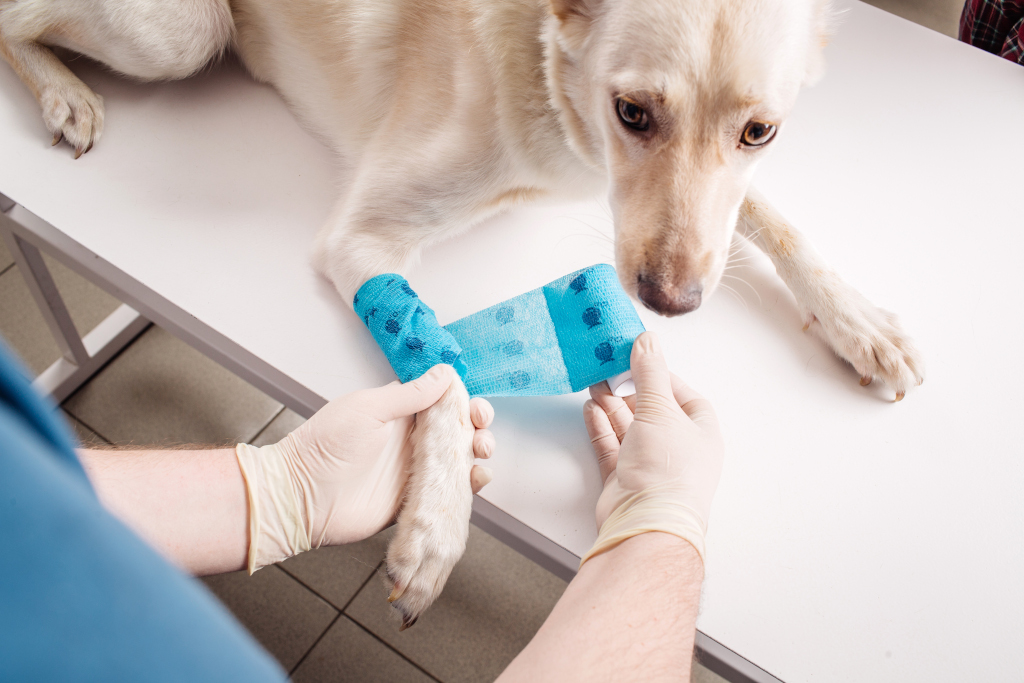
As a runner, I love the idea of canicross, which combines my two favorites: dogs and running. It is a perfect sport for anyone who wants to get into shape while having fun with their canine sidekick!
But unfortunately for many dogs, injuries are inevitable in any physical activity, especially in the great outdoors. Here are some common injuries in dogs that can occur while cross-country running and how to prevent them.
Read More: Does Canicross Encourage Pulling?
1. Paw Cuts
There is plenty of opportunity for your dog’s feet to get cut by sharp objects, stones, sticks, and glass when heading out into the woods on trails. In fact, according to a retrospective survey, the most commonly reported injury in canicross is lacerations, abrasions, and punctures to the paw pad.
The best way to keep paw injuries from happening is by putting on a pair of properly fitting dog boots on your canine before heading out running together. It’s also a good idea to use natural paw ointment regularly on your dog’s pads to prevent dryness and cracking.
Read More: How to Care for Your Dog’s Paws
2. Pulled Muscles or Strains
Just as you can over-stretch your running muscles, so too can your canine. Your dog may also suffer from muscle tears when bounding through the woods, for example, or pushing themselves too hard to win the race, which makes sense if you think about it. When running on the trails, your fido will be coming down hard on its paws with every step!
To prevent this, make sure to warm up and cool down appropriately before and after a run and ensure to give your four-legged friend plenty of rest when the race is finished.
3. Shoulder Injuries
Shoulder injuries can also happen in canicross races, although it is common in canine athletes. This occurs mainly because the dog wears a poorly fitting harness and overuses its shoulders to pull its owner, often at full speed, for an extended time.
So you would want to make sure to get a harness designed explicitly for dog joring sports and that they are comfortable wearing it. You would also need to ensure that your dog has plenty of rest, and again, warming up and cooling down after a workout is essential.
4. Torn ACL
The canine anterior cruciate ligament (ACL) is found in the knee and is responsible for stabilizing your pet’s joint. But unfortunately, like us, their ligaments can get injured or torn due to twisting motions or sudden stops while running at full speed.
To prevent this, you will need to provide your dog with regular exercise and don’t take them to a race without training. Also, make sure to closely supervise your canine during training sessions and competitions to keep them from overexerting themselves.
Read More: Can Dogs Run With A Torn ACL?
Conclusion
If any of the above-mentioned occur mid-race, it can be very painful for your furry canicrosser.
To reduce or minimize the risk of injuries in your dog while canicrossing, you will need to help them warm-up and cool down properly before and after a race. And invest in high-quality doggie booties to protect their feet, as well as a harness that’s designed specifically for pulling to prevent excessive strain on your canine’s shoulders.
It’s also worth mentioning that if you notice your dog’s toenails are too long before the run, you would need to trim those long claws right away. I know that it is not the most fun thing to do, but long nails can crack, break, and bleed, which can be painful.
Lastly, if you ever notice any unusual pains before, during, or after a race or training, make sure to contact a vet immediately.

